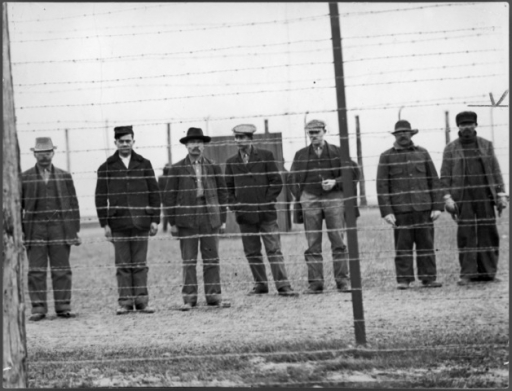The story of thousands of people identified as ‘enemy aliens’ in Canada during the First World War is told in a special exhibition at the Canadian War Museum in Ottawa. Christopher J. Harvie has written a personal viewpoint article for Centenary News on what he says is a difficult aspect of his country’s history.
Featuring photographs sourced from various archives, ‘Enemy Aliens-Internment in Canada,1914-1920’ aims to “explore who they were, the conditions they endured and the legacy they left behind.” The exhibition, developed in partnership with the Ukrainian Canadian Civil Liberties Foundation (UCCLF), runs until March 2015.
Thousands interned
During the First World War, 8,579 people whose national heritage was that of the Central Powers of Germany and Austria-Hungary (including the disparate ethnicities within these empires), were classified as “enemy aliens” and interned in 24 camps set up across Canada.
Professor Lubomyr Luciuk, representing the UCCLF, told me through an email interview: “Thousands of men, and some women and children, were imprisoned, forced to do heavy labour for the profit of their jailers, stripped of what little wealth they had, disenfranchised, and subjected to other state-sanctioned indignities, not because of anything they had done wrong but only because of who they were, where they had come from.”
The War Measures Act
The Governor General of Canada approved the War Measures Act on August 22nd 1914. Its broad powers enabled press censorship and state control of private enterprise, and also allowed the government to detain, indefinitely, any “alien enemy” taken into custody.
The legislation was intended to allow the government to act without obstruction to promote the “security, defence, peace, order and welfare of Canada.”
Section 11 of the WMA, which dealt with “alien enemies” and the detention of such foreigners, was included to assuage public fears of spies, saboteurs and other fifth columnists; and to prevent men with military obligations to the Central Powers from providing service to the enemy. It was further strengthened through an Order-in-Council of October 22nd 1914, authorising the registration and indefinite internment of enemy aliens.
War hysteria, married to an undercurrent of bigotry which was far more prominent than can easily be understood today, allowed for the persecution and detention of foreigners within Canada beyond those with intent to leave the country to fulfill military duties.
In some cases, institutional racism clothed as patriotism excluded men of German, Austrian, Hungarian and Ukrainian descent from finding work. Being placed out of work was classifiable as being destitute and considered cause enough for internment.
Canadian Prime Minister, Stephen Harper, in a 2014 speech on the centenary of the adoption of the War Measures Act said: “A century ago, as a result of fear generated by the onset of the First World War, thousands of new immigrants of European origin were interned…even though there was no proof that they posed a threat to Canada.
“Many of the internees came to our shores seeking to escape oppression and to build a better future for their families, but instead found themselves imprisoned simply for having come from territory controlled by the then German or Austro-Hungarian empires.
“This practice persisted even after the British government advised that most of these so-called ‘enemy aliens’ were in fact sympathetic to our war aims.”
The Exhibition and other memorials
The Canadian War Museum agrees that this is a subject which needs to be addressed with great delicacy. With 33 wall mounted photographs, accompanied by explanatory text, the exhibition describes the process by which immigrants who’d been invited in the late 19th century to settle in Canada were registered and interned. It also looks at conditions in the camps and the legacy of preserving them as memorials.
‘Enemy Aliens’ falls within the difficult subjects surrounding war and conflict which the Museum desires to make more public, reflecting its role as a centre for research, interpretation and discussion.
‘Enemy Aliens-Internment in Canada,1914-1920’ can be seen in the Canadian War Museum’s North Corridor until March 29th 2015. More information is available here.
© Centenary Digital Ltd & Author
Images: City of Toronto Archives, Fonds 1244, Item 867A
